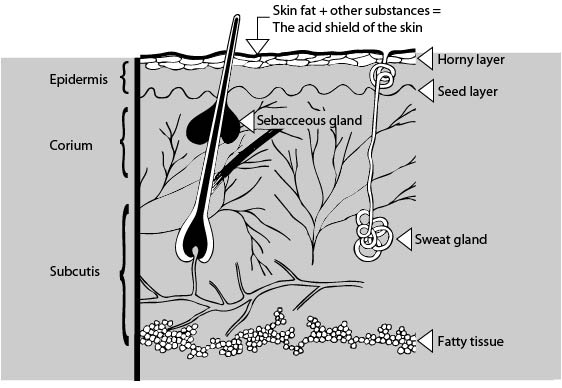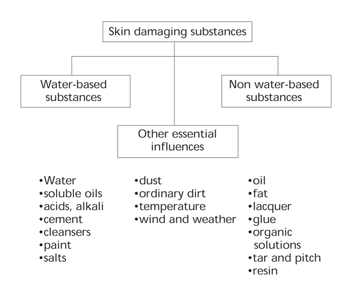What’s under your skin?
Essential facts to help you understand the layers of your skin
The skin is the biggest body organ, with a surface of around 2 m2 and around 1/6 of the total body weight for an adult person. The skin is made of 1-4 mm deep elastic tissue with the main objective of protecting the body against dehydration and daily, external impact. For optimum protection the skin must stay healthy.

3 layers of your skin
Your skin consists of 3 layers:
1. Epidermis
2. Dermis
3. Subcutis
They all serve important fuctions to keep you safe.
1. Epidermis: The epidermis is composed of a layer of dead cells constantly released from the surface. The main protection barrier is found here, preventing micro organisms from invading the body and water from evaporating (the reason why your skin will not dry out). The epidermis produces melanin, which provided protection against the UV radiation of the sun.
2. Dermis: The dermis is the layer of skin with its strong and elastic properties. The dermis is composed of various individual tissue, e.g. hair follicles, sweat glands, sebaceous glands and cells that provide the sense of touch, cool, heat and pain. Additional dermis components are collagen and elastin which provide strength and elasticity to the skin and water binding molecules.
3. Subcutis: The subcutis is a water and blood reservoir. It contains a lipid layer with the purpose of providing insulation, energy storage and protection against pressures. Together with the sweat transmission the lipid content of the skin provides a biologic acid seal protection of the skin. In normal circumstances, the skin is capable of protecting itself.
Protect your skin from external exposure
The 1-4 mm layer protecting your body against external, daily impact, is really not a lot considering the exposure to changing weather and temperature conditions, water, soap, work, etc. Thus, strong impact on the skin is clearly felt. If we could ensure the skin did not come into contact with any dangerous material, it would be able to protect itself – but we can’t. Hence, the natural defence of the skin is gradually deteriorated with every instance of washing and cleaning of your hands, hand disinfection and use of gloves for extended periods of time, because it prevents the skin from breathing.
Sustained and strong impact on the skin from e.g. daily work may create an imbalance to the extent that the skin is unable to restore adequately. There are three categories of dangerous material (water, cleaning agents, dust, oil, etc.) which the skin is exposed to in the workplace: aquatic material, non-aquatic material and other important compounds/exposure:

Any lack of balance may trigger skin issues, which will appear as dry, rough and torn skin and which in a worst case may lead to serious occupational skin disease.
We stress that every person’s skin reaction is different, and its vulnerability may evolve over time and thus the frequency with which preventive use of skin care products is needed will differ too.
One of the best known and acknowledged occupational skin diseases is eczema or dermatitis, of which there are two types:
- Irritative contact dermatitis: The eczema is triggered by the skin being in contact with compounds considerably irritating or degreasing the skin. This type of dermatitis accounts of 80-85 % of all cases
- Allergic contact dermatitis: The eczema is caused by sensitivity to specific material and accounts for 10-15 % of all cases.
Dermatitis represents 94 % of all occupational skin diseases. The most frequently cause is soap, cleaning agents and foods, and often employees working in wet conditions are exposed to eczema. Moreover, eczema may also stem from sensitising substances such as perfume, nickel and preservative agents. First indications of hand dermatitis are reddening, itching and peeling skin, and blisters, itching spots or painful cracking of the skin. The eczema typically appears in areas with thin skin, for example between fingers, over the knuckles or below a ring on the finger.
Once eczema appears, you should contact a doctor. Continued use of appropriate hand hygiene, however, will need to be supplemented or replaced with hormone-based lotion. Appropriate hand hygiene procedures and correct products do only go as far as preventing occupational skin diseases – they are not the cure against them! Nonetheless, you will be on the right track by keeping your hands clean and healthy and establishing the optimum barriers against skin damage by:
- Using skin care products prior to and during your work, preventing the skin from drying during the day and keeping it smooth and resistant to exposure
- Cleaning your hands with soap, hand cleaning agent and hand disinfection
- Using skin care products after work, re-establishing the natural skin protection properties
The best prevention method is a properly designed hand hygiene programme. Skin diseases are a big financial burden for society and corporates coupled with the significant personal and physical repercussions for the impacted people.
